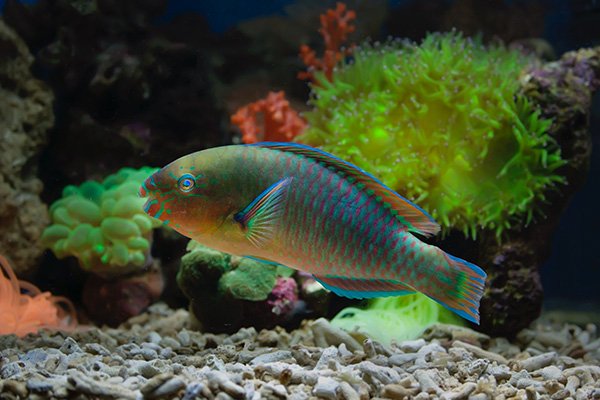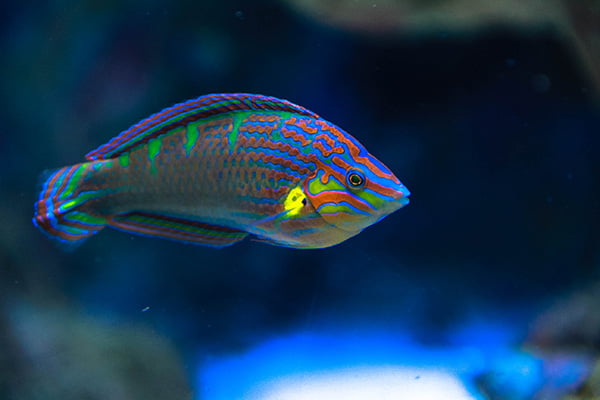From the tropical shores of Southeast Asia to the vibrant reefs of the Caribbean and the Pacific Islands, the cultural traditions and culinary delights of eating parrotfish bring joy to those who appreciate its unique flavors. However, these beautiful coral reef grazers also make a stunning addition to the aquarium and will leave you in awe.
Parrotfish are colorful fish with bird-like beaks, fused teeth, and fascinating patterns. With their unique personalities and striking appearance, parrotfish will transform your aquarium into a living work of art. And parrotfish play a significant role in maintaining the health and balance of coral reefs through their unique feeding habits and the subsequent release of their waste, often referred to as "parrotfish poop."
While parrotfish populations currently remain relatively stable, the increasing challenges of rising ocean temperatures, pollution, and fishing pose significant threats to this charismatic marine life and its delicate ecosystems. So if you are thinking of adding parrotfish to your aquarium, read below to learn everything you need to know about keeping parrotfish as a pet.
About Parrotfish
Size
Parrotfish come in a variety of sizes, with the exact size depending on the specific species. On average, Parrotfish range from small to medium-sized, typically measuring between 6 to 20 inches (15 to 50 cm) in length. However, some larger species can grow up to 3 feet (90 cm) long. It's important to research the specific species you plan to keep as a pet to understand its potential size and ensure you have an appropriately sized tank to accommodate its growth.
Life Expectancy
The lifespan of parrotfish, on average, is between 10 to 15 years. With the appropriate housing, feeding, and aquarium care, these fish can live long and healthy lives. However, with proper care, a healthy diet, and a suitable environment, some Parrotfish species have been known to live up to 20 years or even longer.
Temperament
Parrotfish are generally known to have a peaceful temperament, and they are not usually aggressive towards other fish and can coexist well in a community aquarium. However, it's important to recognize that the temperament of parrotfish can vary not only between different species but also within the same species, making it crucial to observe and understand the unique behaviors and characteristics of each individual fish.
Some larger Parrotfish may become territorial as they grow older and may display aggressive behavior towards other fish, especially if they feel their space is being invaded. Providing ample space, hiding spots, and suitable tank size is always recommended to minimize potential aggression. Monitoring the behavior of your parrotfish and carefully selecting compatible tank mates can help create a harmonious and stress-free environment for all inhabitants of the aquarium.

How To Care For Parrotfish
Tank Size
Parrotfish require a spacious tank due to their active nature and potential growth. The tank should be adequately sized to allow for swimming and territorial behavior. As a general guideline, a minimum tank size of 50 gallons is recommended for small to medium-sized parrotfish, with larger species requiring even larger tanks.
Water Parameters
Parrotfish flourish in aquariums that provide optimal conditions, ensuring stable water quality and a well-maintained environment for their health and well-being. They prefer a temperature range of 75-82°F (24-28°C) and a pH level between 6.5 and 7.5. Maintaining optimal water quality for parrotfish requires regular water testing and the use of appropriate filtration systems to ensure a healthy and thriving aquatic environment.
Substrate and Decorations
Provide a fine sand substrate or fine-grained gravel to mimic their natural habitat. Parrotfish enjoy sifting through the substrate, searching for food, and creating small burrows. Include plenty of live rock or artificial structures to create hiding spots, caves, and a variety of swimming areas. Driftwood, clay pots, java fern, hornwort, anubias, and other river and basin flora and debris are also recommended.
Water Filter
When choosing a filter, consider factors such as the size of your tank, the number of fish, the waste production, and the water flow requirements of parrotfish. It's essential to maintain the filter regularly by cleaning or replacing the media as instructed by the manufacturer. Additionally, regular water testing and maintenance will help ensure the filter operates optimally and provides a clean and healthy environment for your parrotfish.
Heat
These fish can handle a wider range of temperatures than other fish because they live in the wild. Parrotfish like 72-82°F (22-28°C). To keep these fish comfortable and healthy, try to keep the temperature between 76-80°F. To grow properly, eggs and baby fish should keep this temperature year-round.
Using a reliable aquarium heater is the most common way to regulate the water temperature in a fish tank. Choose a heater with a thermostat that allows you to set and maintain the desired temperature. For optimal heat distribution, it is recommended to position the heater near the water flow, such as the outlet of the filter, in order to maintain a consistent and suitable temperature throughout the aquarium for the well-being of the parrotfish.
Tank Mates
These peaceful fish do well with other species, and some of the best tank mates include larger tetras, cory catfish, rainbowfish, and bristle nose plecos. But you should always monitor the behavior of the tank mates and be prepared to make adjustments if any aggression or compatibility issues arise.
Light
Like other fish, parrotfish benefit from a consistent lighting schedule to mimic their natural habitat. Provide a regular lighting schedule for your parrotfish, ideally simulating a day-night cycle. Aim for 10-12 hours of light during the day and 10-12 hours of darkness at night. Using a timer for your aquarium lights can help maintain a consistent schedule.
Parrotfish generally thrive in aquariums with moderate to bright lighting. Consider using full-spectrum LED lights or fluorescent lights that provide a balanced spectrum of light. This helps support the growth of beneficial algae and enhances the vibrant colors of the fish.
Feeding
Parrotfish are algae grazers from Rocks, coral, seaweed, inside of coral polyps, and other surfaces. Parrotfish teeth are razor-sharp and powerful. Similar to their distant relatives, moray eels, parrotfish possess an interesting adaptation: a secondary set of teeth known as pharyngeal teeth, located towards the back of their throat.
Even though parrotfish teeth have tough teeth, they struggle to feed on tank surface water, so you should feed them flakes. Parrotfish prefer pellets because they settle to the bottom of the aquarium, and Cichlid pellets should be considered when choosing pellets. Feed them enough nutritious food to keep their vivid colors, avoid stress, and live a healthy life.
Parrotfish naturally feed on algae and seaweed in the wild. You can provide dried seaweed or algae sheets specifically designed for herbivorous fish. Attach these sheets to a feeding clip or rock inside the tank, allowing the parrotfish to graze on them. Supplement the pellet diet with fresh vegetables. Offer a variety of blanched or finely chopped veggies like spinach, kale, lettuce, zucchini, and cucumber. These vegetables provide additional fiber and nutrients.
Avoid feeding parrotfish meaty or protein-rich foods, as their digestive systems are not designed to process high amounts of animal-based proteins. Stick to a predominantly vegetarian diet to meet their nutritional requirements.

Parrotfish Species
There are numerous species of parrotfish, each with its own unique characteristics and colorations. Some of the notable subspecies of parrotfish include:
Scarus Coeruleus (Blue Parrotfish): This subspecies is known for its vibrant blue coloration and a distinct beak-like mouth.
Scarus Vetula (Stoplight Parrotfish): The Stoplight Parrotfish showcases a striking combination of colors, with a red body, yellow fins, and a vibrant blue spot near the tail.
Bicolor Parrotfish: The Bicolor Parrotfish displays a fascinating color pattern, featuring a bright green or bluish head transitioning to a pink or reddish body.
Princess Parrotfish: The Princess Parrotfish exhibits a mix of pastel shades, including pink, lavender, and blue, creating a visually enchanting appearance.
Rusty Parrotfish: The Rusty Parrotfish showcases an earthy color palette, with a rusty brown or reddish body and contrasting blue or green accents.
Midnight Parrotfish: The Midnight Parrotfish features a predominantly dark coloration, with shades of deep blue or black, making it a visually striking species.
Bumphead Parrotfish: The Bumphead Parrotfish displays a stunning combination of vibrant blues, yellows, and intricate patterns during its juvenile stage, transitioning to a darker gray or brownish color as it matures.
Mediterranean Parrotfish: The Mediterranean Parrotfish exhibits a vibrant array of colors, including shades of blues, greens, yellows, and pinks, adding a splash of beauty to the Mediterranean Sea.
Green humphead Parrotfish: The Green Humphead Parrotfish boasts a stunning emerald green coloration, captivating the eyes with its vibrant and iridescent beauty.
Potential Health & Behavioral Issues
Ich (White Spot Disease)
Ichthyophthirius multifiliis, commonly referred to as ich, is a parasitic infection that manifests as unsightly white spots on the body, fins, and gills of fish. This condition can lead to discomfort, excessive scratching, and respiratory difficulties in affected parrotfish.
Fin Rot
Fin rot is a bacterial infection that can affect the fins and tail of parrotfish. This condition is often triggered by factors such as inadequate water quality, heightened stress levels, or physical injuries experienced by the parrotfish. Fin rot can lead to frayed or disintegrating fins if left untreated.
Parasitic Infections
Parrotfish can be vulnerable to various external parasites such as flukes, worms, and protozoa. These parasites can cause irritation, skin lesions, and other health issues.
Malnutrition
Inadequate nutrition can lead to various health problems in parrotfish, including stunted growth, weakened immune system, and disease susceptibility. A balanced diet rich in plant-based foods is essential for their overall health and well-being.
